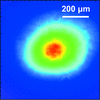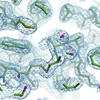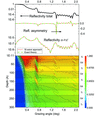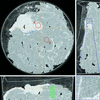issue contents
March 2019 issue

Cover illustration: Interpolated images of apparent chlorine (top) and sulfur (bottom) quantitation for glial cells as calculated using blank correction (left) or per-pixel baseline correction (right). The cells were contaminated with small crystals of sodium chloride which dominate the chlorine signal (see Crawford, Deb and Penner-Hahn, pages 497-503). Despite this contamination, blank correction can recover the sulfur signal (lower left) while baseline distortions leaves apparent `holes' in the chlorine distribution in the spots that had high chlorine (lower right).
facility information
research papers
 access
access access
access access
access access
access access
access access
access access
accessSerial synchrotron data were collected in flow in a simple microfluidic device under flow-focusing conditions which allowed sample consumption to be reduced compared with other previously reported liquid-flow devices. A pulsed data collection strategy prevented the formation of hydrogen bubbles in the chip and the high repetition rate allowed for a short data collection time.
 access
access access
access access
accessbeamlines
 access
access access
access access
access access
accessaddenda and errata
 access
access


 journal menu
journal menu






























































